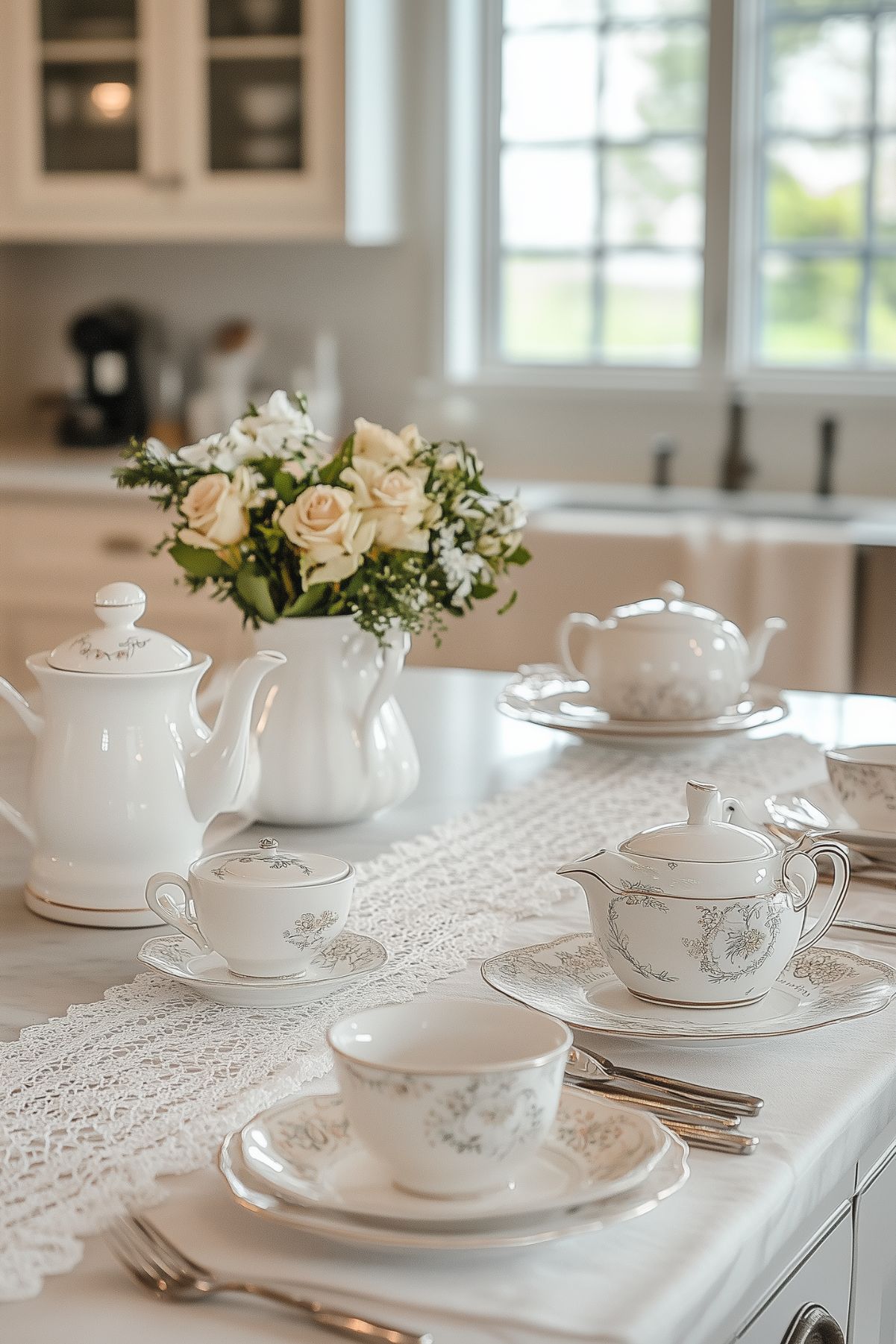In recent years, the grandmillennial style has gained popularity, especially in kitchen design. This aesthetic combines modern trends with a love for vintage charm, creating spaces that feel both fresh and nostalgic.
Lace and linens play a significant role in this style by adding texture and warmth, making kitchens inviting and stylish.

Incorporating these fabrics can transform a kitchen from ordinary to extraordinary.
Delicate lace curtains may frame windows, while patterned table linens bring color and personality.
By curating a collection of these elements, homeowners can create a space that reflects their personal history and appreciation for tradition.
As they explore how to enhance their kitchens, readers will find that embracing lace and linens contributes to the grandmillennial vibe. These timeless materials not only offer aesthetic appeal but also help to establish a sense of comfort and familiarity within the heart of the home.
The Grandmillennial Style

The Grandmillennial style embraces a blend of nostalgia and modern sensibilities. This design trend prioritizes comfort and individuality, creating inviting spaces that often feel like a warm hug from the past.
Lace and linens play a significant role in establishing this aesthetic.
Defining Grandmillennial Aesthetics
Grandmillennial aesthetics reflect a mix of traditional and contemporary elements. Characterized by bold patterns, vintage pieces, and rich textures, this style incorporates elements such as florals, ruffles, and embroidered fabrics.
Color palettes tend to be soft yet vibrant, often combining pastels with more saturated tones.
The look is eclectic; it invites layering items with sentimental value alongside sleek modern touches.
Linens with intricate designs are often favored, contributing to a cozy, lived-in atmosphere. Many people appreciate how Grandmillennial decor feels familiar and new, all at once.
Historical Influences on Grandmillennial Decor
Grandmillennial decor often draws inspiration from past design trends. Home decor from the 1980s and early 1990s greatly influences this style, reflecting a nostalgic longing for the homes of childhood.
Features like floral patterns, lace details, and heirloom-quality textiles often find their way into modern designs.
This trend reflects a rebellion against the minimalism that has dominated interior design for years. Instead of stark lines and empty spaces, it celebrates detail and warmth.
The style is also a nod to previous generations’ tastes, mixing classic elements with a modern twist.
Collectibles, vintage furniture, and familiar decor items enhance this rich, layered look.
Importance of Lace and Linens in Grandmillennial Decor

Lace and linens hold significant value in Grandmillennial decor, enriching spaces with texture and sophistication.
These elements blend tradition with modernity, making them essential for creating a cozy yet stylish atmosphere.
Textiles as Comfort Elements
Textiles like lace and linens bring a warm, inviting feel to kitchens. They add comfort in practical ways, like using linen tablecloths or lace doilies to soften hard surfaces.
These fabrics are often light and breathable, enhancing the comfort of a space.
Additionally, textiles in various textures contribute to cozy vibes.
A mix of soft linens for napkins and delicate lace accents creates a homey environment. This combination encourages gatherings, making the kitchen a favored spot for family and friends.
Visual Appeal of Lace and Linens
Visually, lace and linens offer striking contrasts against other decor elements. Lace brings an element of elegance, while linens can introduce cheerful colors or patterns.
This diversity helps achieve the eclectic look that defines Grandmillennial style.
Using lace table runners or embroidered napkins showcases craftsmanship and attention to detail.
These fabrics also pair well with vintage dishes and wooden furniture, enhancing the overall aesthetics. It’s this thoughtful blend that transforms a kitchen into a lovely focal point in the home.
Selecting Lace and Linens for Kitchens

Choosing the right lace and linens for a kitchen involves considering quality and durability as well as the patterns, colors, and textures that will enhance the space.
These elements play a vital role in creating a cozy and inviting atmosphere while ensuring practicality.
Quality and Durability Considerations
When selecting lace and linens, quality is key. High-quality fabrics will last longer and withstand regular use.
Cotton and linen are excellent choices for kitchen items. They are breathable and easy to clean.
It’s wise to check the thread count and material weight.
A higher thread count usually means better quality, making items feel softer and more luxurious.
Look for materials that resist fading and stains, especially if they will be exposed to spills.
Linens that are machine washable can save time and effort. Investing in durable fabrics can lead to long-term savings and a beautiful kitchen.
Patterns, Colors, and Textures
Patterns and colors can greatly impact the kitchen’s appearance.
Grandmillennial style often features floral prints, lace trims, and vibrant hues. These elements can add warmth and character to the space.
Choosing the right textures can also influence the feel of the kitchen.
Smooth, crisp linens offer a fresh look, while lace can provide a touch of elegance.
Consider the theme of the kitchen when selecting colors and patterns. Nautical stripes or tropical prints can set a cheerful mood.
Mixing and matching can create visual interest, making the kitchen a fun place to be.
Practical Uses of Lace and Linens

Lace and linens can add both functionality and style to the grandmillennial kitchen. They offer practical solutions for everyday tasks while also enhancing the overall design.
Functionality in Everyday Kitchen Tasks
Lace and linens serve many practical purposes in the kitchen.
For example, linen towels are highly absorbent and can handle spills effectively. They are ideal for drying dishes or covering baked goods.
Using lace such as doilies can provide a decorative touch on serving trays. This adds charm and helps keep items neatly in place.
Additionally, linen tablecloths protect countertops or dining tables from heat and scratches.
Another functional use is for pot holders made from thick linen or lace. They can safely handle hot dishes and add an elegant twist to serving.
Creating a Cohesive Look
In a grandmillennial kitchen, design cohesion is essential. Lace and linens help create a unified aesthetic that reflects personal style.
Coordinating linens, such as matching napkins and tablecloths, can transform a simple meal into a lovely gathering.
Lace accents work well alongside vintage dishware, creating an inviting atmosphere.
Mixing various textures, including lace curtains or placemats with linen textiles, adds depth to the decor.
Choosing colors that complement the overall kitchen palette is key.
Soft pastels or classic whites enhance the traditional feel while still keeping it modern.
Arranging linens and lace thoughtfully can make the kitchen a warm, welcoming space.
Maintenance and Care

Maintaining lace and linens in a grandmillennial kitchen requires proper cleaning and storage techniques. This ensures their beauty and longevity while preserving the charm they add to the space.
Cleaning Best Practices
For cleaning lace and linens, it is essential to know the right methods. First, always check the care label for specific instructions.
- Gentle Cycle: Use a gentle cycle for machine washing, if the item is machine washable.
- Cold Water: Wash with cold water to avoid shrinking or damage.
- Mild Detergent: Opt for a mild detergent that won’t harm delicate fabrics.
For delicate lace, hand washing is often best.
- Soak: Soak in a mixture of cold water and gentle soap for a few minutes.
- Rinse Thoroughly: Ensure all soap is rinsed out to avoid buildup.
After washing, lay linens flat to dry. Avoid direct sunlight to prevent fading and harsh drying.
Preservation Tips for Longevity
Storing linens and lace properly is crucial for their preservation.
- Cool, Dry Place: Always store them in a cool, dry place to prevent mildew.
- Breathable Materials: Use cotton or muslin to wrap them, as plastic can trap moisture.
For added protection against dust and pests:
- Storage Bins: Choose bins with lids that allow airflow.
- Avoid Overpacking: Never overpack to allow for free movement and prevent creasing.
Lastly, consider refreshing linens regularly by ironing them. Use a low heat setting to maintain fabric integrity while ensuring they look their best.
Styling Tips for Lace and Linens

Lace and linens can elevate a Grandmillennial kitchen, adding both charm and elegance.
Mixing vintage elements with modern trends highlights the unique qualities of these materials, while seasonal decor ideas can make the space inviting and warm.
Mixing Vintage and Modern Pieces
Combining vintage lace and modern linens creates a harmonious look.
To achieve this, start with a modern tablecloth or runner in a neutral color. Then layer vintage lace doilies or intricate placemats on top.
This contrast brings visual interest without overwhelming the space.
Incorporate assorted vintage pieces, like antique salt and pepper shakers or ceramic dishware. Pairing these with contemporary ceramics can give the kitchen a cozy yet stylish feel.
Don’t forget to include lace accents in curtains or napkins. These details can contribute to a warm atmosphere and reflect personal style.
Seasonal and Festive Decor Ideas
Seasonal decor is an easy way to keep a kitchen fresh and inviting.
For spring, consider bright linen tablecloths paired with delicate lace overlays. Add fresh flowers in vintage vases for an uplifting touch.
In autumn, switch to deeper colors like burnt orange or mustard yellow linens. Layer with lace accent pieces for a cozy vibe.
For the holidays, use festive table runners and lace napkin rings.
To create a cheerful summer atmosphere, opt for airy linen curtains that let in natural light.
Use lace accents in decorative bowls or centerpieces to maintain that charming feel. This approach enhances the kitchen’s warmth and makes it welcoming for guests.













